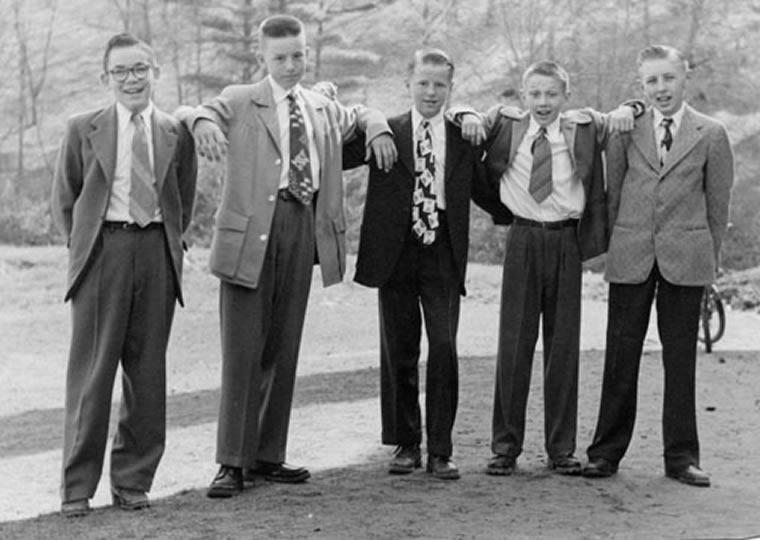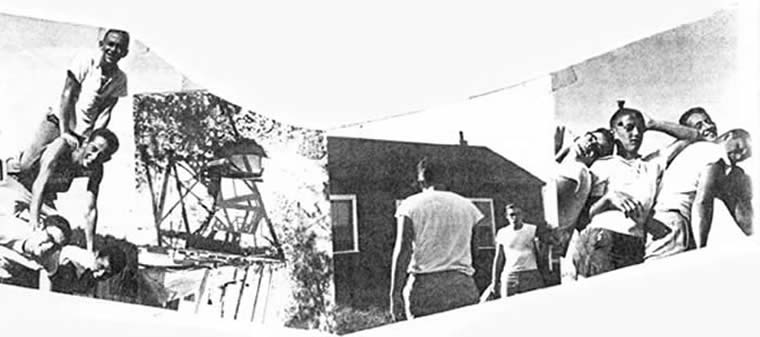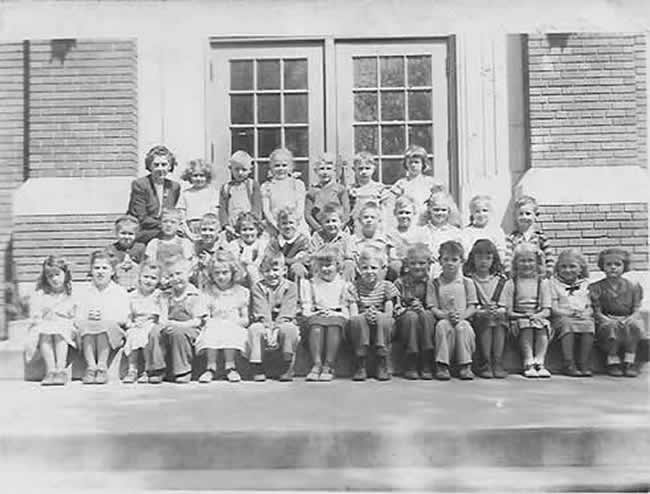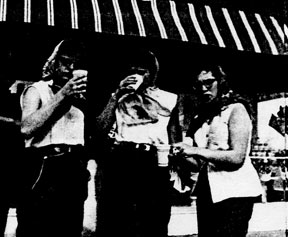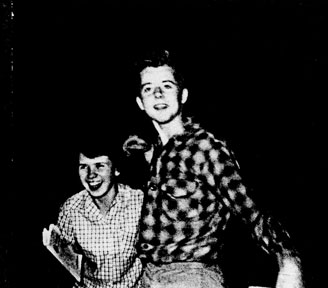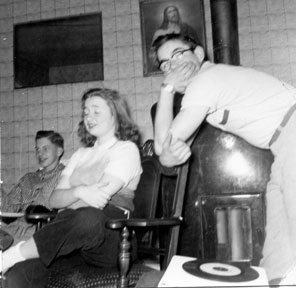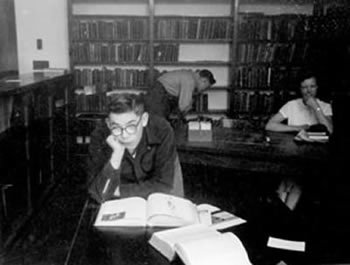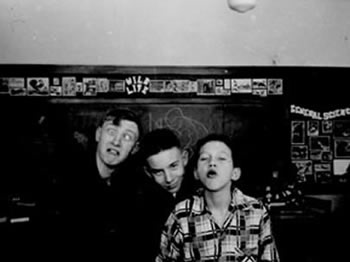Jerry Forthun's Memories
| Over the years since graduating from Spring Valley High School, Jerry Forthun has written some of his memories of growing up in Spring Valley, Wisconsin, as well as a piece called "A Father's Message". They are posted here for your enjoyment along with some Forthun Motel memories: |
Introduction
After my
retirement from the social work field in criminal justice at the end of 1992 I
began to dabble around with writing a few poems and short stories about various
family events over the past 50 years or so. I always had in the back of my mind the notion that it would
be fun to write down a few memories of my growing-up years in Spring
Valley. As is usually the case,
however, I found various reasons to keep that project on the back burner.
It got moved to the front burner
after I talked with Rosemary Meier at the All-class Spring Valley High School
Reunion at Baldwin in August of 1999.
It was the first time that I had talked with Rosemary since Jim’s death,
and during the course of our conversation she asked me if I would be willing to
write down a few of my memories of growing up in Spring Valley. She said that she was interested in
“some of the things the guys did together” during our growing-up years. I have to thank Rosemary, therefore,
for giving me the little push that I needed to write the following pages.
This little collection of memories
is dedicated to Jim Meier. He was
one of my best friends during the 12 years we spent at Spring Valley Elementary
and High School. We spent
countless hours together in school and on the playgrounds and streets of Spring
Valley. He was always a very loyal
and faithful friend, and I miss him.
I consider myself very fortunate to have had him for a friend those many
years.
I apologize for the imperfections
in this little booklet. At the
time I wrote it I did not have a PC or any other hi-tech equipment. My word processor was getting old and
tired, just like me, and the roller was a bit loose—therefore the uneven
spacing between the lines at times.
I printed my copies of photos (not included in this version) and used a
binding machine at the local Office-Plus store, and therefore I had to make a
“copy from a copy”, which deteriorated the sharpness of the photos. It’s the best I could do with what I
had.
I have included a
one-page story that I wrote a couple of years ago for a family reunion
yearbook, entitled “Monkey Business.”
This will partially fulfill our 8th grade prophecy that I
would write a novel by the same name.
I also have included a short story that I wrote a few years ago
entitled “Me and My Bike.”
I hope that you will find these
little stories informative and entertaining, and I welcome any comments you
might have after reading them.
GJF
Manitou Beach,
Michigan, October, 1999
1st and 2nd grades, Spring Valley Elementary School May 1946 |
1st Grade in Row 1 & 2nd Grade in Rows 2 & 3 Row 3: Mrs. McKernon, Rosemary Wolf, Jim Tabor, Nancy Hanson, Frank Erb, Steve Hanson, Monica Grant. |
Growing up in Spring Valley was a
pretty neat experience. I suppose
that there were more beautiful small towns than Spring Valley, and certainly
more sophisticated villages in other parts of the country, but I think that it
was a good place to grow up in. In
the 1940’s and 50’s Spring Valley was a bustling little farm community, with
big crowds up and down the streets on Fridays and Saturdays. From visiting the village in recent
years I have been struck by how much the business district has declined, when
comparing it to what was going on in the 1950’s. Most people apparently now go to larger cities in the area
to do their shopping, and the business section of town has definitely suffered
from that lack of business.
My parents, Dr. Stanley and Clara
Forthun, settled in Spring Valley a short time after their marriage in
February, 1927. Dad worked, I
believe, with another chiropractor for a period of time before opening his own
office. For many years his office
was on the south end of town next to Ed Garlie’s (later Joe Langer’s) grocery
store. That grocery store was located where the present post office is
positioned. On the corner was a
very small restaurant that we always referred to as “The Greasy Spoon.” I remember being in Garlie’s Store a
lot during my younger years. I
remember Ed (and Iva Nelson)
reaching up on the high shelves with a long stick with a clamp on the end to
pick a can of vegetables or a roll of toilet paper off the shelf. My brother Dick tells the story that Ed
used to have him standing-by in the store to run errands. Whenever a customer wanted something
that Ed didn’t have in stock, Ed would quietly go over to Dick and tell him to
run out of the back door to the nearest grocery store competitor and buy the
product and bring it back so that Ed could provide what his unsuspecting
customer wanted. At the end of the
customer transaction, when the store patron walked out of the front door with
his or her bags of groceries, Ed
and Iva always said something that sounded like “Taks-gotta-ha!”. I think that meant “thank you” in
Norwegian.
Our family lived in at least 4
different houses around the village between 1927 and 1942. Early on they lived in the house just
south of the school, in the house that was later owned by Matt Hanson. They also lived “over the tire shop”
(as Mom referred to it), which I believe was in the old building where the Pontiac
Garage was later built. They lived
in “the Casey House” on top of Church Hill for a few years, also in a house
just down the street from the Wolf’s for awhile, and finally on the 2nd
floor above my father’s office just next to Ed Garlie’s Store. We were living there when I was born, I
believe, and stayed there until the big flood of September 17, 1942 wrecked our
home and convinced my dad that “it was time to get out of Dodge” and relocate
to higher ground. On the lower end
of town the water was so high during the 1942 flood that one could reach out of
a second-story window and touch the water. In the summer of 1943 he moved the top part of the house 1.5
miles west of town on Highway 29, remodeled it and built-on a new office. In 1948 he built a 4-unit motel. He practiced chiropractic for 50 years
and ran the motel until shortly after Clara’s death in 1975.
After the big flood in September,
1942, our family left our flood-ruined house in Spring Valley and moved in with
my mother’s parents in Wausau, while my dad found an office to practice in over
the next several months. After he
had the house moved 1.5 miles west on Highway 29 and rebuilt it with an
attached office, we moved back into the house in the summer of 1943.
I started 1st grade at
Spring Valley in the fall of 1944.
I remember vaguely the feeling that I had missed out on something since
I had not attended Kindergarten in Spring Valley with the other kids in my
class. I think that I also felt a
little out of it since I lived about a mile and a half from town and I
therefore didn’t get to spend as much time with my classmates as the “town
kids” did after school and in the evenings and on weekends.
During my first few years in school
I became close friends with Jim Meier and Bob Langer. Jim and I had a lot of things in common. In addition to being classmates we were
both the youngest in our families and we also both went to the
Catholic Church in town. I think that because we spent that
extra time together (in church and other religious activities) we had a little
closer bond. Back in those days
the schools were a little more accommodating to the churches in town. The Catholic kids, for example, were
excused from school during the last hour on Tuesdays, so that they could go to
a catechism class being taught in the home of a good Catholic mother – i.e.,
Gert Sweeney, Verne Richardson, Ethyl Madson and others. The Catholic kids also had a “summer
school” for about 2 weeks during June, using the facilities of the elementary
school. Several nuns were brought
in from Eau Claire to teach the two-week summer religious course. Most of these nuns were pretty young,
and it was a real trip to see them out on the softball field in their black
& white “habits.” They were
still wearing the old traditional garb in those days. In spite of some of the bad things one hears about their
experiences being taught by nuns, I have nothing but the greatest respect for
those nuns who taught us in summer school those many years. They were dedicated educators who made
a difference in our lives.
Jim was also kind of a “soul mate” to me during our early high school years. He was the person I talked with the most about my personal philosophy of life. Jim and spent many summer nights together just talking for hours. Sometimes we would sit out on the patio in front of my dad’s office and look up at the stars and wonder about different things going on in our lives. We talked about girls a lot, and other important things in our lives, what we hoped to do, and wondered what life held in store for us in the years to come. We both had a strong philosophical streak in us and we enjoyed sharing it with each other.
These are three pages from an autograph book given to each of us at Christmas of1948 by Mrs. Anderson, our 5th grade teacher. |
|
Vern Ellefson signed the page, and later someone else added the art work (the elephant). Somehow I think that Russ Pence or Dave Larson did the art work. |
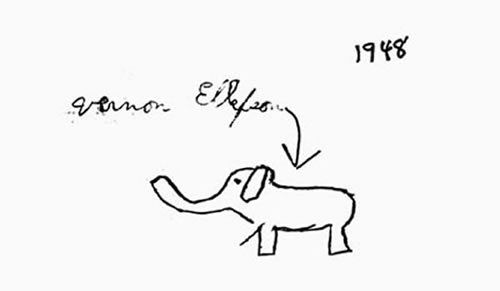 |
The "Roses are Red, Violets are Blue" verses were very popular. 5th graders weren't about to say nice things to eachother - especially boys to girls, or visa versa. |
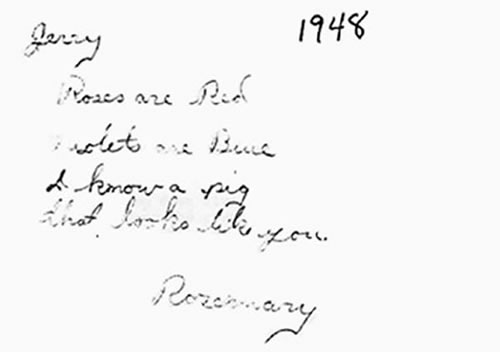 |
Bob Langer was waxing poetic in this 1953 verse offering. We were already learning certain important lessons about life in the 8th grade, as you can see. |
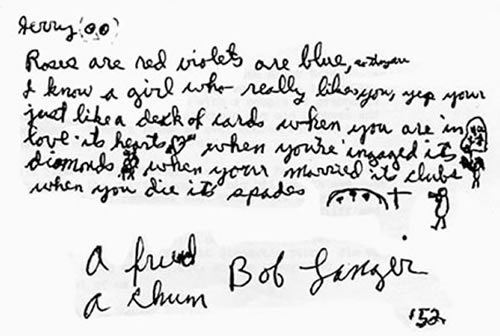 |
In retrospect, it is interesting to
note that Jim and I both gravitated toward careers that involved a lot of
writing. I think that we both
believed that the “written word” somehow had a lot more power than the spoken
word. Both of us became interested
in journaling about our life’s experiences and about our family histories. I think that we both felt that we were
making a significant contribution by writing down some of the secrets of a good
life that we believed we had found during our lifetimes.
During our first several years of
grade school we enjoyed a lot of things outside of the classroom, of
course. I remember playing marbles
for several years with some of the guys.
We’d pick up a little twig and draw a circle in the dirt. We’d each put a marble in the circle and
then pitch our shooter to the lag-line to see who would shoot first. There were the control words of “Ebbs,
Dotts, Nuckles-Down-Tight” and so on. Everybody had their favorite shooter, and
sometimes you saw a brilliantly colored red or yellow marble. We really tried hard to knock those
really pretty ones out of the circle so we could take them home. Once in awhile you saw a big “steelie”,
which was a ball-bearing used as a marble. Those big things should have been outlawed! The kids in the
class above us were always better at everything, of course, and so we always
tried to stay with our own age group as much as possible. I still have about a hundred or so
marbles among my memorabilia, some of which bring back an emotional feeling in
the pit of my stomach when I look at and touch them.
We also played a game during recess
periods on the south side of the school that involved running between the wall
of the school and the fence which bordered on Matt Hanson’s property. It was kind of a tag game and if you
were tagged you were “it” and had to stand between the wall and the fence and
try to tag someone else as they ran back and forth. The fastest runners, of course, were seldom tagged. In the
fall of the year when the big long-stemmed reeds were dried out they made good
spears, and we would pull them out of the ground and see who could throw one
the furthest across the river by the school. And who will forget the 6th grade boys climbing
out of the window of Miss Wold’s classroom and climbing down the brick wall to
the ground. I think we got into
some hot water over that one! After
remembering what we put Miss Wold through that year I can’t imagine why anyone
would want to teach 6th grade!
I remember in the early grades
walking down River Street, the unofficial name given to the street that ran
along the river, and on which the school was located. Tim Sandvig lived about a block south of the school, and we
frequently stopped at his place.
Tim and I were close friends through many of our school years, and we
did a lot of things together. I
remember that he was crazy about horses, and during class and at other times he
was always sketching a horse head.
I remember an experience with Tim when we must have been in our early
teens. Tim had a minnow-trapping
business to make a few bucks. He
invited me to go with him on one of his trips up the Eau Galle to the area I
believe was called Rocky Coulee.
That area is now under the lake north of the damn. Anyway, we went at least a couple of
miles north with 4 or 5 minnow traps and a big minnow box to dump the minnows
into from the traps. The traps
were clear plastic, about 18 inches long, with each end funneling in to a small
hole that entered the trap. It was
easy for the minnows to swim into, but very difficult for them to find their
way out. I remember that when Tim
got a big load of minnows in his box he had to find a way to get them back to
town in a hurry before many of the minnows perished. I can remember that that was quite a challenge.
One of our trips up the river was
one I will never forget. We camped
overnight on a sandy beach beside a beautiful deep pool of the river. Early the next morning I remember that
we got up and went swimming in that beautiful pool with the sun brilliantly
shining through the water. I
remember the feeling that we were in a very remote area, certainly one that I
had never seen before, and I had the feeling that this was truly a pristine
location to camp out. Maybe nobody
else had camped there since the Indians did a long time ago. Whenever I went camping out for a day
or two my mother always loaded me down with all kinds of paraphernalia. She said, “This or That will always
come in handy.” I remember once
when she had me pack a small pressure cooker to cook food in. Tim got a good laugh out of that!
One of the things I remember doing
with Tim when we were in high school and were old enough to drive a car was
when Tim took his Uncle Joe Bailey’s big black Cadillac up to the Pontiac
Garage to wash it. That was pretty
accommodating of the folks in the car dealerships in town to let people come in
and wash their own cars. I don’t
remember how much they charged for a person to wash his own car, but I guess it
wasn’t much, if anything. I
remember rubbing pretty hard to get spots off that old Cadillac, as we had to
do a very thorough job. Tim
reminded me that his Uncle Joe was pretty particular about having a clean car
and always said “that the car RAN BETTER if it was clean.”
When our gang was in the early
grades, I remember walking in a group down River Street on Friday afternoons to
the old football field down by the Lutheran Church. The high school football games were played in the afternoon
since there were no lights on that old football field. I think that they played games down
there until maybe 1946 or so before the new football field with lights was
constructed up by the smelter tower.
I will always remember walking to and from those football games with the
smell of burning leaves in the air.
Next to summer and all its delicious activities, I liked fall next best.
I also remember spending time down
around the “South Black Bridge” as we called it. When we were in our early grades we used to lie belly-down
on the bridge and hang a fishing line with a couple of grab-hooks down into the
water. We’d grab-hook some of
those big old suckers and yank them up on the bank. I don’t think that we ever cooked and ate those suckers but
I think that maybe Otto Siegert did.
Jim and I would walk from the black
bridge east to his house, along a sandy pathway which hugged the cliff along
the big hill which was just east of the Eau Galle River. I remember that there were a couple of
areas along that path where kids had dug into the sandstone cliff and made some
small caves, which we used to escape from the rain if we happened to be in that
area during a sudden storm. I remember that in Jim’s front yard there was a
metal swing/glider which we used to swing on once in awhile. Since Jim’s house was just down the
street from Otto Siegert’s place, Jim was our authority on what was going on
with Otto, and he always had a good story to relate to the rest of us.
7th and 8th Grade Team, 1952 |
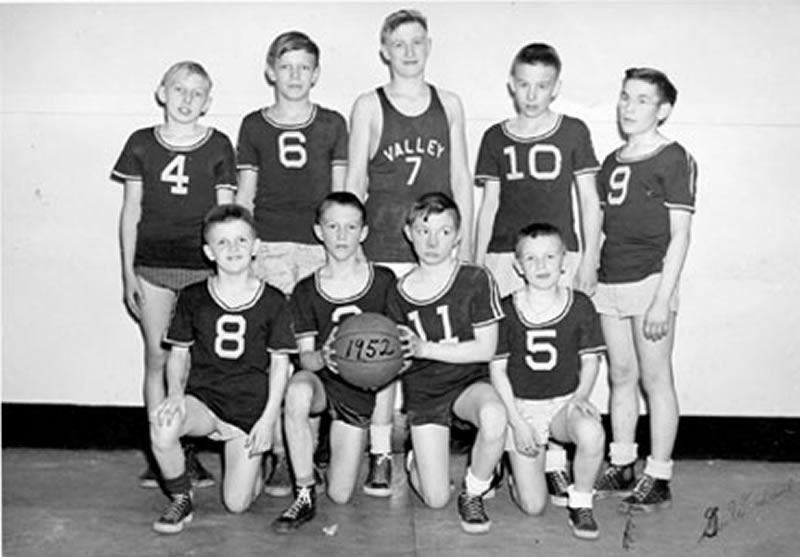 |
Back, L to R: Jim Tabor, Dennis Gilbertson, Vernon Ellefson, Jerry Forthun, Jim Meier. Front, L to R: Dave Richardson, Bob Langer, Steve Hanson, Bob Richardson |
One of the guys in our class was
Jim Tabor. His family lived in a
house high up on Church Hill on the west side of the village. One of the most vivid memories I have
of Jim T. is going up to his place to watch television. This must have been around 1946 or
thereabouts, and his dad was one of the first people in town to get a TV
set. The TV screen was really
small, maybe 7 to 10 inches across, and of course was in black and white and
very “snowy.” One of the first
things I remember watching was college football games on Saturdays, usually Ivy
League teams, and you had to watch very intently, as there was a lot of
interference and you frequently lost the picture in a “snow storm.”
During winter months we spent a lot
of time building snow forts, having snowball fights and sledding. We also did a little ice-skating on the
Eau Galle River and maybe about 1950 or so the school started flooding a nice
ice-rink on the north side of the school, complete with a “warming house.” As I recall, the warming house really
wasn’t very warm, but al least it was a place out of the wind where you could
put on or take off your skates, and rest your sore ankles for awhile.
8th Grade Graduation Day - May, 1953
|
L to R: Jim Meier, Jerry Forthun, Dave Litzell (with a tie I loaned him), Bob Langer (with almost no tie), and Jim Tabor (looking pretty dapper). Photo taken by George Wentland, looking east toward the river at the north end of the school. |
All of the way through grade school
and up into high school, of course, one of our big pastimes was sports. From about 2nd grade on we
played softball out on the playground in the spring and summer, and football in
the fall. I remember our guys
playing tackle football against the guys from the grade ahead of us. It was plenty rough. For some reason I don’t remember
playing against the guys in the class behind us. There must be some profound psychological reason for this
phenomenon! Probably in about the
6th grade we started having more of less organized games of
basketball, mostly in the (then) new school gymnasium. Since the gym floor was pretty new, our
principal, Mr. Syverson (“Syver”) was pretty insistent that we wear only
basketball shoes or go barefoot or stocking-footed on the floor--no street shoes
that might leave black scuff-marks.
As I look back on my early years in
Spring Valley, I have to think that one of the most significant steps in my
growth (and in the lives of most of the other boys) was the day I got my first
bicycle. This was particularly
true in my case since our family lived about a mile and a half out of
town. With a bicycle I was mobile,
and it brought me closer together to the other guys in a matter of a few
minutes. I must admit, however,
that my first bike was a 24” girl’s bike, previously owned by Judy Bailey. I only rode that bike around for a year
or two before I got a used 26” boy’s bike. That was an exciting time in my life! I worked together with my brother Tom
to completely restore the old bike.
We took apart the coaster brake assembly, cleaned and lubricated it, and
repainted the frame a dark green.
I painted the fenders a lighter shade of green. I put on new handle-bar grips (with
streamers, of course,) a new seat and new pedals. When it was all done I felt like I had a new bike - I was very
happy! That was about 1948, when I
was 10. Incidentally, I didn’t get
my first new bike until 1972, when I was 34 years old.
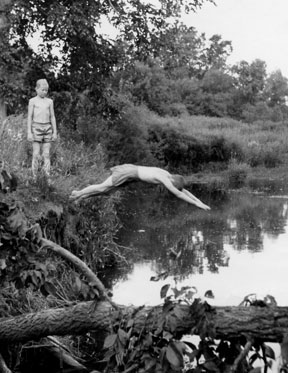 |
| Dave & Jerry at the swimming hole. '53 |
On long summer days we put a lot of
miles on our bikes. During the
afternoons we frequently rode our bikes north of the village to the swimming
holes on the Eau Galle. When we
were young we went to a swimming hole on Louie Longseth’s farm. Later we went across Lamb’s farm to
“First Rock”, and then after a few years we began to go to a bigger swimming
hole just a few hundred feet north of First Rock. When I was very young I remember going swimming a few times
down by the Burma Bridge, on the way to Elmwood. I think that my brother Dick and his friends used to swim
down there quite a bit.
During the time we swam in the First Rock area we went frequently,
probably three times a week or so.
In the early spring, right after the snow thaw, some of us would go up
to the swimming hole and jump into the water and quickly swim across the river,
just to prove how tough we were.
The water temperature must have been about 40 degrees, and we were lucky
that we didn’t cramp up and sink to the bottom!
Another thing that several of the
guys did about 8th and 9th grades was ride our bikes up
to the village dump, which was located about a half mile north of the North
Black Bridge. The great sport we
enjoyed was shooting rats with our .22 rifles. Vern Ellefson, Tim Sandvig and Bob Langer are some of the
names that come to mind when I think of rat hunting at the dump. We used to keep score on how many we
had nailed on a given day and, as I recall, on a good day we scored hits on 15
or 20 of the little critters. It
was like a war-zone at the dump in those days. There were little fires constantly smoldering throughout the
whole area. The smell of the smoke
and rotting trash was not good. It
was war! It was the good guys
versus the rats, and we were serious about our war games!
We definitely helped to keep the
rat population very closely controlled at the Spring Valley Village Dump. Of course, you had to be a little
careful when someone stopped by the dump to drop off some trash. In those days it could’ve been
hazardous on one’s health to stop at the dump to drop off trash. There were, interestingly, a few locals
who regularly made a trip to the dump to look for treasures that had been
thrown away by others. Nowadays we
call it dumpster-diving, and it is still a popular sport!
In about the 3rd
grade, Vern Ellefson moved out to
our neighborhood in “Buntville,” as we called it at that time. A year or two later the Litzell family
moved into the “hood”, and Dave and I became pretty close friends. I remember particularly sledding with
Dave and Vern on bright, icy winter nights. They lived up on the top of the hill and I lived down at the
bottom We really had a blast
after an ice storm because the road (sled path down the hill) was glare-ice and
the sledding was very fast. Back
in those days they didn’t put salty-sand on the icy roads like they do now, so
the sledding was very good for several days after an ice storm. It wasn’t so great, however, for the
folks who had to drive their cars up and down that icy road.
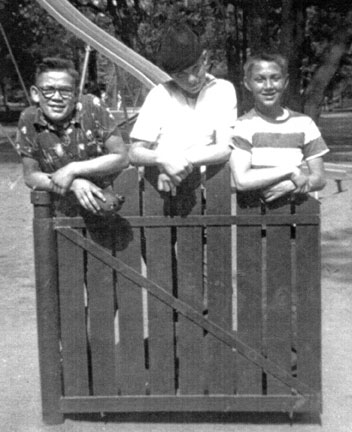 |
L to R: Jim Meier, Jerry Forthun, Bob Langer. Photo taken apparently during a class picnic, probably about 1950 or '51. Photographer and location unknown. |
We spent a lot of time tramping
through the woods just north and west of Buntville. We built a tree-house in a big basswood tree along a fence
line, and I spent many a night in that tree-house with several different
friends (one at a time, since there was only room for two to sleep up there.)
Since this tree-house did not have a roof we had to pay attention to the
weather forecast, and despite the forecast I recall getting wet a few times,
and also waking up with green worms all over me. On the positive side, the basswood tree was beautiful when
it was decked out in thousands of white blossoms every June!
Vern and Dave and I used to walk
over to the old mink farm. The
original farmhouse had burned down, probably around 1948, and now there was a
mobile home parked on the farm. Vern assured us that he was good friends with the owner so we would walk
in and look for a pack of the guy’s cigarettes. I think that they were Chesterfields. That was really forbidden stuff for me
at that time. Although my dad
smoked cigarettes until 1962, he was strongly opposed to my having anything to
do with such things. I would have
been scared to death to pilfer one of his cigarettes. Luckily we got into athletics in high school and I think
that helped us to pretty much leave tobacco and alcohol alone until after high
school—almost.
One of the activities that the guys
spent a lot of time on during the summer months was camping, and sometimes
fishing, and sometimes fishing and camping, and sometimes hunting. I probably did more squirrel
hunting with Tim Sandvig than with anyone else. We hunted several different woods through many beautiful
Octobers. We both really enjoyed
tramping through those beautifully colored woods, and always looked forward to
trying a pristine woods where the squirrels were less experienced dealing with
hunters. Tim hunted with his
Marlin .22 caliber bolt-action clip-fed rifle and I carried my old .22
caliber Remington semi-automatic
rifle that fired only short cartridges. I had been able to buy that rifle from a game warden who confiscated it
from a hunter who was in some kind of violation. Tim was a pretty shrewd hunter. He knew that those wily squirrels would keep backing around
the tree trunks to stay out of our sight.
He always had a little smile (or was it a smirk?) on his face when he
had me walk around the tree trunk so that the little critter would move around
to his side and give either him or me a good shot. We always got a few - usually bushy-tailed fox-squirrels, and
we usually cleaned them right out in the woods and took them home in a brown
paper bag.
Vern Ellefson and Tim were probably the most serious fishermen, but Jim and Bob and I sometimes
wet a line together. Most of us
were involved in the Boy Scouts and went on camping trips together. I can remember lots of weekend camping
trips when we would camp out with small “pup” tents that were big enough for
only 2 persons. They didn’t have a
floor in them, so if it rained (which seemed to happen a lot) the water came
under the wall of the tent and got everything wet. That made for a long weekend. I remember a couple of camping trips when it rained the
whole time we were out there. Our
clothes and blankets were always damp, and if we had a campfire the wood was
green and wet and smoked and sizzled a lot. We didn’t smell very good when we got home from one of those
weekends.
Many of our gang also went up north
to summer camps that lasted either a week or two weeks. I remember that there was a camp on the
St. Croix River, and also a Camp Neibel, which was up in that area but I
believe on a small lake. I believe
that Jim and Bob and Dave Litzell and I went to those camps maybe 4 or 5 times
between 4th and 8th grades. We did a lot of swimming and canoeing during those days. I
vividly remember kneeling down on
the wooden ribs of those Old Town canoes for an hour or more at a time. When you finally got up out of the
canoe your knees had deep indentations and you could hardly walk. Sometimes we made canoe trips which
lasted several hours. On one
occasion we camped out up-river at a place called Worm Island. We slept under our canoes, and of
course it rained that night—and yes there were hundreds of green worms on us
when we woke up in the morning! In
the evenings at camp we sat around a fire-pit and told stories and sang
songs. You really got to know the
people you camped with pretty well.
You had to work together to take care of the necessary details to
survive (and hopefully stay dry) and you definitely learned in a hurry who you
were comfortable being around. We
also went over to the Pierce County Fair at Ellsworth and camped out on the
fairgrounds. We were able to walk
up and down the midway for hours at a time, wearing our Boy Scout uniforms--
feeling important-- like we were really doing something essential for the good of the
world. I think we did
that about 2 or 3 years.
As I look back to those times I
realize that one of the things I really appreciated about camping with Jim was
that he was so easy to talk with. All of the guys were pretty good to camp with, but Jim made me feel more
comfortable because he was very unassuming and had a quiet, dry sense of
humor. He also was a very good
listener, and made you feel that you were on the same wave-length. Another of the qualities that I really
appreciated about Jim was that he didn’t tease and “put down” his friends the
way some of the other guys did. That made me feel that our friendship was genuine and I didn’t have to
be on my guard around him, as I sometimes did when I was around some of my
other friends.
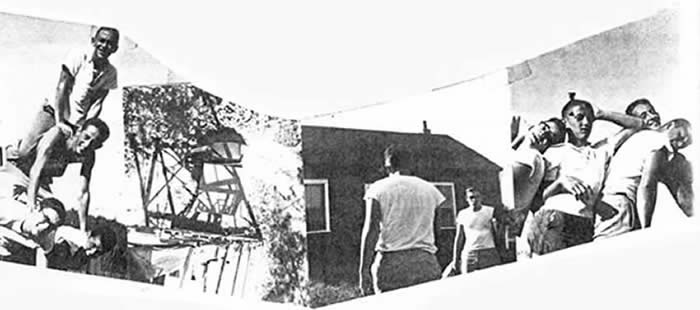 |
| Photos taken at Hayward, c '55. Bob, Russ, Jim, Tim and Jerry were there. |
Somewhat related to our camping
trips were our trips to Hayward. There’s an old expression that proclaims that Hayward was a wild
place: “Hayward, Hurley, and Hell!” But we really didn’t go up there for a
wild time. My dad was a part-owner
of a hunting lodge, located about 11 miles east of Hayward, so we started
making almost yearly trips up there for a little change of pace from Spring
Valley life. For the first few
years I would go up with my dad, and take 2 or 3 of my friends with me. During the last 2 years that I went up
with my friends, we stayed there without any parents, so things got just a
little bit wilder. The hunting
lodge was pretty rustic. As I
recall there was a hand-pump for water, but I think that we had to carry water
up there with us if we wanted good drinking water. We took turns cooking simple meals on an old electric
hotplate—at least there was electricity! One of the most enjoyable features of the hunting cabin was the old pool
table located in the middle of the one-room building. We spent a lot of hours on that old pool table, which had
been hauled up there from our basement in Spring Valley many years before. There was also an old pinball
machine that got a lot of use, all hours of the day and night. The lawn around the cabin was always
completely overgrown because it only got mowed once a year when we took the
lawn-mower up there. There was a
pretty good sized pond about 50 yards from the cabin. My dad said that they had
planted a bunch of fish in that pond years earlier, but I always believed that the only thing in that pond was
mosquitoes - and there were millions!
I think that it was the summer of
1953 (maybe 1954) that we hauled our bicycles up there to Hayward so we would
have some means of transportation (we were still too young to drive a car). I’m not sure that worked out real well. It was an 11-mile ride into Hayward, and we all had
“one-speed” bikes (the 10-speeds were not popular yet). Going up and down all those hills on
the way to Hayward and back
definitely pooped us all out! I’m
certain that we all slept well that night. I think that it was the summer of ’55 that we drove my ol’
1936 Chevie up to Hayward. It
looked kinda like a beast - painted red and white and didn’t have a grill on the
front. Bob Langer still talks
about the times that on-coming cars pulled off to the side of the road to let
us pass by - not knowing who, or WHAT we were.
It was during that last trip to Hayward, I believe,
that we went to the Sportsmen’s Bar. We were only 16 or 17 at the time, of course, and we couldn’t drink
alcohol, but I think that they let us wander through the place because it was
such a famous tourist attraction. There were numerous huge game-fish mounted in glass showcases on the
walls. Hayward at that time
claimed to be the "Muskie Capital of the World.” They probably still make the same claim. We always had a pretty good time up at
Hayward, but sometimes the “put-downs” and teasing got pretty bad. Bob got so upset with the teasing he got
on one of our trips to Hayward that he ended up hitch-hiking back to Spring
Valley by himself. That’s kinda
scary when you think about it now.
| Eighth Grade Graduation, Spring Valley, Wisconsin - May, 1952 |
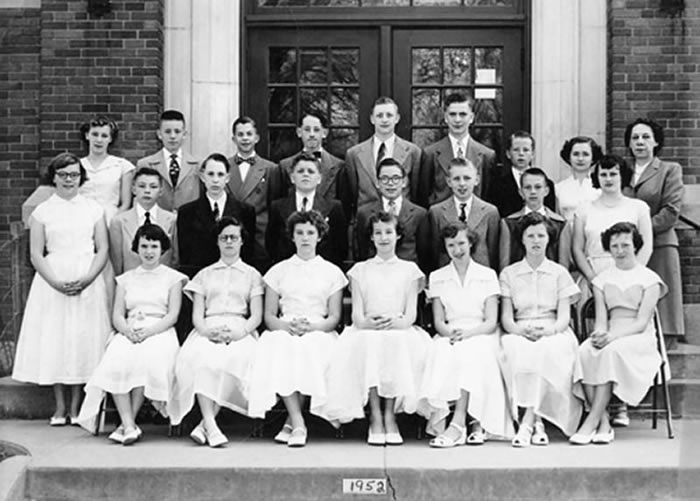 |
Top, L to R: Alice Andrews, Jerry Forthun, Dave Larson, Russ Pence, Vern Ellefson, Bob Jacobson, Dave Litzell, Rosemary Wolf, Miss Helen Crowley. 2nd Row, L to R: Nancy Hanson, Steven Hanson, Ellis Barsness, Tim Sandvig, Jim Meier, Jim Tabor, Bob Langer, Karen Thompson. 1st Row, L to R: Mary Jo Richardson, JoAnn Hanson, Bev Hogen, Kay Thome, Amanda Timm, Lorraine Jacobson, Helen Holerud. |
JoAnn, Bev & Sandy, c. '54 |
Senior Class Play Rehearsal - Mary Jo and Dave - '56 |
Record party at the Thome's (I think). Dave, Rosie and Jim, c '55 |
|
Jim, pretending to study, c '55 |
Vern, Jerry, Bob: Clowning, c '55 |
As we entered our high school years many things changed in our “guy relationships”. Two things happened which really changed how much time we spent with the other guys. One, of course, was the fact that girls became much more important. Some of my buddies started going steady with their girlfriends, and friendships and relationships shifted. I began spending more time with friends who did not have a steady girlfriend, as I did not either. It was interesting to note how I had close friendships with different people, as the years went by. I always had a pretty close friendship with Jim Meier and with Bob Langer, but during certain periods of school years I was also close with Tim Sandvig, Mickey Adank, Vern Ellefson, Dave Litzell and Dave Larson. The second force that I refer to above which changed relationships is the arrival of driver’s licenses and cars. Later in high school I became fairly close with Jon Hillstead, who was a sports nut who also didn’t have a steady girlfriend. Jon, of course, did not join our class until 9th grade. He was one of the out-of-towners who joined us when we went into high school. I remember that Jon loved sports statistics, and even in high school he said he wanted to be a sports statistician. I think that he became a math teacher in real life - which is a pretty good gig and a noble profession and a pretty good compromise! Jon and I had some good talks during our last few years in school. We had a lot in common.
After I left high school and spent a few years in the Navy, I went to college and majored in psychology and sociology. While I was in my last year at River Falls, in the fall of 1962, I wrote a term paper about Spring Valley for one of my sociology classes. Unfortunately I either threw it away or otherwise lost it some time ago, but I remember that it was fascinating to analyze some of the demographics and social and economic factors of Spring Valley, and compare them with what we see today happening in our society
A quick glance at the photo of our second grade class of 1946 reminds me of how much our parents were the backbone of the village of Spring Valley. The fathers of most of our classmates were owners or employees of small businesses in the Valley. Rosemary’s dad had the hardware store and heating business, Jim T’s dad was a manager at the Spring Valley Produce Co., Nancy’s dad had the bakery, Mary Jo’s dad had an insurance business, Jim M’s dad was a mail carrier, Bob’s mom operated Lorraine’s Bar (the best in town), Karen’s dad had a restaurant business, Dave’s dad operated a gas station, my dad was a chiropractor and had a small motel, Kay’s dad was a blacksmith, and Russ’s dad had a hardware store and radio and TV shop. In 9th grade many joined us who operated farms with their families. Every family made a clear contribution to the welfare of Spring Valley. Most of our parents knew our classmates as well as their parents, and everyone was concerned about everybody else’s welfare. Most of the time that was a good thing (although there were times when we may have wished that everybody wouldn’t know everybody else’s business.) It was a tight community of people who cared about each other.
It is also interesting to note that almost every family was a two-parent family, living together. The few one-parent families were due mostly to death rather than divorce. In almost every family the father worked, while the mother was a full-time stay-at-home-mom. Almost everyone belonged to one of the three churches in town and attended regularly. As I have gotten older I have longed for that kind of stability in our society today. Things are obviously very different. I am now a confirmed old fogey or geezer who, as many generations of old fogies and geezers have done before me, strongly believe that “things used to be better in the old days".
Many of our school memories are captured in the school yearbooks, the “Mirrors”, which were published every year, so I won’t talk here any more about school activities. I would mention, however, the fun we had during “extra-curricular” activities like building the floats for the Homecoming celebration each year. Who will ever forget the night that a certain un-named person was sent down to the bowling alley to get a bucket of steam? We always had a lot of laughs working on those crazy floats - “We’re Expecting Victory” (stork on float), and “We Udder Defeat” (cow on float) - who thought of those things??? Other times that bring back a flood of fond memories are the class-play rehearsals that we had. Pretty much the same group of people were in both our Junior and Senior class plays. We spent a lot of hours together and had a lot of laughs, while at the same time developing our self confidence a little bit. Of such stuff are lifelong memories constructed.
We were fortunate to have grown up in that time, in that place. (I remember a poem from our English class with a title like that.) People now say that the 1950’s were a time of innocence and simple living - not nearly as complicated and fraught with social problems and dangers that the current generation faces. They can call our generation of the 50’s anything they want to. We are often referred to as simple and unsophisticated compared to other generations. I say that we are a pretty good generation, having grown up during and after a big (justified) war, we learned to work pretty hard and play pretty hard too. I’m happy that I grew up in Spring Valley with a bunch of really neat people. As I look back on those early years in Spring Valley I can honestly say that I don’t remember anyone that I actually disliked - and I remember a lot of people that I really liked. I don’t think that one could ask for anything better than that.
G.J. Forthun, Manitou Beach, MI, October 12, 1999
Although we had many pets through the years, the most memorable was Jack. Jack was a Rhesus monkey that Doc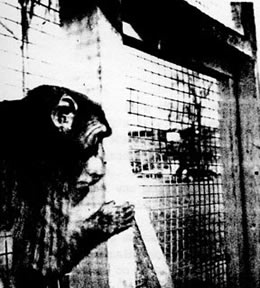 had obtained from a local farm lady by the name of Mollie Jensen. Mollie had a hobby of collecting exotic as well as local wild animals, and she had a large number, perhaps 40 to 50 different species of animals in cages on her farm.Some of them, like the large peacocks, wandered around the farm and were not caged. We had a lot of fun going out to her farm on numerous occasions. She was a neat lady. Doc got Jack from her around 1952, when I was 14 years old. Jack was a wild animal—he was not the kind of monkey you would carry around on your shoulder. He would bite you in a heartbeat if you tried to touch him, so he was always kept in his cage. Dad had Phil Gasteyer build the cage, about 10’ by 4’ by 6’ high. It was framed with 2 x 4’s with a heavy chicken-wire wrapped around it. After a period of time the chicken-wire stretched out because Jack bounced back and forth from one side of the cage to the other throughout the day. We had to replace the chicken-wire with a stronger welded wire fencing to withstand the punishment that Jack gave it. His cage had a small compartment on the upper back end with a swinging door on it so that he could escape the elements as well as the kids who frequently teased him.
had obtained from a local farm lady by the name of Mollie Jensen. Mollie had a hobby of collecting exotic as well as local wild animals, and she had a large number, perhaps 40 to 50 different species of animals in cages on her farm.Some of them, like the large peacocks, wandered around the farm and were not caged. We had a lot of fun going out to her farm on numerous occasions. She was a neat lady. Doc got Jack from her around 1952, when I was 14 years old. Jack was a wild animal—he was not the kind of monkey you would carry around on your shoulder. He would bite you in a heartbeat if you tried to touch him, so he was always kept in his cage. Dad had Phil Gasteyer build the cage, about 10’ by 4’ by 6’ high. It was framed with 2 x 4’s with a heavy chicken-wire wrapped around it. After a period of time the chicken-wire stretched out because Jack bounced back and forth from one side of the cage to the other throughout the day. We had to replace the chicken-wire with a stronger welded wire fencing to withstand the punishment that Jack gave it. His cage had a small compartment on the upper back end with a swinging door on it so that he could escape the elements as well as the kids who frequently teased him.
I probably teased him more than anyone else so he undoubtedly didn’t like me very much. Once in awhile, during warm weather I gave him a little bath with my squirt-gun. That’s probably the only bath he ever got. Jack tried to get back at me by bouncing hard against the sides of his cage when I approached. A few times he peed on me when I wasn’t alert enough to get out of the way. I was the one who usually fed him. As I recall he didn’t eat much meat, if any. We mostly fed him vegetables and fruits - he obviously really liked bananas and could peel and eat one in about 15 seconds. He liked peanuts too. Of course he peeled everything that we gave him, as he obviously thought everything was supposed to be peeled. He even peeled the chocolate coating off from Cheerios (chocolate covered vanilla ice-cream bar on a stick.) Maybe he knew something about chocolate that the rest of us didn’t know.
Early in the first winter that we had him, we had a crisis. Although Doc had rigged up a small heater for him in his outside cage, it was obvious that he was too cold. So early one weekday morning in December Doc decided to bring Jack into the house while Phil Gasteyer built an inside cage for him in the basement. I remember that I was getting ready to go to school around 7:30 a.m. when Doc went out to Jack’s cage, grabbed him and carried him through the back porch into Clara’s kitchen. This whole thing only took about 15 seconds, but it was an eventful 15 seconds. Like I said earlier, Jack didn’t like to be touched, so the whole time Doc was carrying him he was biting him HARD on his bare arms. Doc was hollering bloody murder the whole time. After Doc deposited Jack on the kitchen table he hurried off to treat his severely bitten arms with antiseptic. There were several deep bite-marks up and down his arms. Doc already had patients in his office waiting for treatment - THAT was definitely not the way he wanted to start off the day—by having to administer first-aid treatment to himself!
When Doc had first told Clara that he was going to bring Jack in from the cold into her kitchen while Phil built a cage for him in the basement, he told her: “Don’t worry, Clara, Jack will be so happy just to be inside where it’s warm that he will behave himself”. Well, Doc was wrong - Jack didn’t behave himself. For the next 8 hours or so while Phil worked very hard PUTTING TOGETHER Jack’s new cage down in the basement, Jack worked very hard on TAKING APART Clara’s kitchen. He pulled open the cupboard doors and started throwing things out on the floor. Some of the food items he ate, but most of the packages of food were just opened up and the contents dumped on the floor. He also threw down some glassware and smashed them on the sink and the floor. He seemed to take pleasure in opening a jar of honey or corn syrup and slowly pouring it out on the other food items that he had deposited on the floor. Luckily Clara had quickly closed the kitchen door going into the living room so Jack’s 8 hours of demolition were confined to the kitchen. It’s a wonder that Clara (or Doc) didn’t have a heart attack that day.
When I came home from school Jack was still in the kitchen doing his thing. In addition to all of the things he had thrown on the floor, he of course had relieved himself a few times around the kitchen. An hour or so after I got home Phil finished building the cage in the basement, and I got to watch “The Capture”. The plan was to throw a blanket over Jack and wrap him up in it so he wouldn’t be able to bite anyone while he was being carried to his new home. It sounded like a good plan, but it took a lot longer than was expected.As Phil approached Jack to throw a blanket over him Jack ran ACROSS the kitchen wall and landed on top of the refrigerator. Now Phil was a pretty short guy, and he couldn’t get a real good angle to throw the blanket up over Jack’s head. For the first few tries as Phil threw the blanket up to cover Jack, Jack caught the blanket and threw it back over PHIL’S head. (This would have made a great home-video!) This went on for several minutes before Phil and Doc were finally able to get Jack wrapped up in the blanket and carry him to his new cage.
After we had had Jack for about 3 years he became too much of a nuisance, and possibly a liability for Doc. Jack started to find ways to get out of his cage, and on a few occasions he threatened and scared some of Doc’s patients as they arrived in the parking area. It was the beginning of the end for Jack. On August 23rd, 1955, Dad called Phil Gasteyer to come out to the house and bring his .22 rifle with him. On that day Spring Valley had its first “drive-by shooting” as I drove the ’52 Chevie slowly by Jack’s cage. He was loose again, sitting on top of his cage. Phil stuck his rifle out of the back window and shot Jack once in the head. I buried Jack later in the back yard. I was tearful. I was so emotional that I felt compelled to write a poem to commemorate Jack. I titled it: “If Jack Were Alive.”
IF JACK WERE ALIVE by Gerald Forthun |
If Jack were alive, what would be the position And disposition of us—his slaves? Might not we at this very moment Be captivated by that mysterious Force of his personality? Might not we be offering Our humble services And sacrificing our choicest morsels To this hairy god? Or might not we be giving him drink If he so desired? Might not we be subjected to his rage, Merely because of our insolence In bringing forth an audience Without his approval? Might not we be warning our fellow subjects Of the might and rage of this insidious monarch? We who have borne this burden Shudder in his wake But wonder of the emptiness Of this Black Tuesday— The day of his death. August 23, 1955 |
By G. J. Forthun
1949. It’s summertime! One of the most fun times of my life! This is a big year in my family’s life, because everyone is graduating from something. My sister Mary graduated from what was then Wisconsin State Teacher’s college at River Falls. My brother Richard had graduated from Spring Valley High School, and my brother tom had graduated from 8th grade. I was the only one who hadn’t “graduated”, but I had completed the 5th grade and I was promoted to the sixth grade - to Miss Wold’s class, or as we boys called her, “Moldy Woldy.”
During summers, my bicycle was my life. I lived about 1 1/2 miles out of Spring Valley, Wisconsin, so I needed “wheels” desperately! On a hot summer afternoon I could go anywhere on my bike. Without my bike I was doomed to stay at home and try to find something to do. Sometimes I experimented with gravity. The road to town was Wisconsin Highway 29, and was paved with asphalt, so it was easy going. The first part of the trip to town was almost flat, with a very slight decline heading into Spring Valley, or “the Gulch”, as we sometimes called it. About half way to town the decline increased and so, of course, did your speed. A few times I started out in front of our house and didn’t pedal my bike even once, to see if gravity would take me all the way into town. It was very slow for the first 1/4 mile or so, and then I started to pick up speed. By the time I got to the outskirts of town I was really cruisin’ - had to use my brakes to be on the safe side. It was fun riding my bike into town because it was all downhill—but that meant that heading back home at the end of the day wasn’t fun at all, because it was all uphill. I think I learned something about life during those countless trips to and from town for all those years. The downhill trips of life are great fun—but sooner or later you have to pay the price for the fun. Our lives can’t be all downhill if we want to live in the real world.
A lot of my activities during the summer took place on or in the river, just north of town. A 15 minute bike ride and a 10 minute walk took you to First Rock, which was named for a rock cliff along the banks of the Eau Galle River. The swimming hole was just up-river from First Rock, and was a bigger pool and was quiet and cool. Right at First Rock the river was narrower, and flowed quickly with a little whitewater. The cliff extended over the river, so it was usually in the shade when we went there in the afternoons. I can still remember the taste of river water in my mouth and the feeling of being cool and clean when I toweled off and put my clothes back on. We were always a little exhausted when we finished swimming, and on our way back to our bikes we had to be careful to not brush up against the nettles along the riverbank. After leaving the swimming hole I usually parted company with my friends and started the uphill trip to my home. I was always hungry when I got home and Mom was always ready to fix me a sandwich or was maybe already preparing supper. I still remember the smell of boiled potatoes and celery in the air.
My bike was really the center of my existence for many years while I was growing up. I remember my first bike - it was a 24 inch red girls bike that had been owned by Judy Bailey. I must have been in maybe the 1st or 2nd grade, and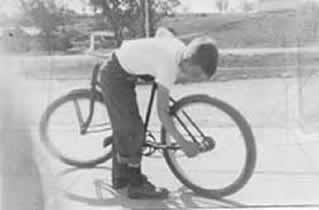 even at that time I remember that it was humiliating that I had to ride a girl’s bike. By the 3rd or 4th grade I was given another used bike - this time a 26 inch boys bike. I can still remember that I was excited about graduating to a 26 inch bike, and I spent a lot of time working with my brother Tom to repaint and restore it. During a period of a year or two, my brother Tom repaired used bikes and sold them for a little profit. I can remember suspending a bike rim between two wooden coke cases standing on their ends so that it could be rotated to see how straight it was spinning. It was necessary to tighten or loosen the spokes in the appropriate places to straighten the rim so it wouldn’t rub on the bike frame. Those were the days before 10-speeds. All the bikes I saw had the Bendix coaster brakes, and when the brakes didn’t work you had to replace the little metal ring with the knob on the end. Your bikes could be dressed up with fancy pedals and handle bar grips with plastic streamers that fluttered in the wind. During the parades on Memorial Day or 4th of July or Homecoming all the kids rode their bikes somewhere near the action - sometimes dressed up with colored crepe paper braided through the spokes of the bike wheels.
even at that time I remember that it was humiliating that I had to ride a girl’s bike. By the 3rd or 4th grade I was given another used bike - this time a 26 inch boys bike. I can still remember that I was excited about graduating to a 26 inch bike, and I spent a lot of time working with my brother Tom to repaint and restore it. During a period of a year or two, my brother Tom repaired used bikes and sold them for a little profit. I can remember suspending a bike rim between two wooden coke cases standing on their ends so that it could be rotated to see how straight it was spinning. It was necessary to tighten or loosen the spokes in the appropriate places to straighten the rim so it wouldn’t rub on the bike frame. Those were the days before 10-speeds. All the bikes I saw had the Bendix coaster brakes, and when the brakes didn’t work you had to replace the little metal ring with the knob on the end. Your bikes could be dressed up with fancy pedals and handle bar grips with plastic streamers that fluttered in the wind. During the parades on Memorial Day or 4th of July or Homecoming all the kids rode their bikes somewhere near the action - sometimes dressed up with colored crepe paper braided through the spokes of the bike wheels.
In the photo on the previous page I see myself working on my bike. It seems like something always needed to be tightened or adjusted so it would work right. There was no rear fender, so needless to say I got a muddy stripe up the back of my shirt when it was rainy. I usually had my pant-leg rolled up so it wouldn’t get caught in the chain, or get grease or oil off the chain. I wasn’t rich enough to have a bike with a chain guard. Besides, chain guards were for girls anyway. From the picture you can see that I spent a lot of time in the sun—one of the hazards of being a young boy in the summertime. I can see the white rocks along the driveway in front of Dad’s office. I can remember painting those rocks white, and then moving each one back onto the driveway while I mowed the grass - then moved the rocks back again to the proper place.
I can remember mowing the lawns and pruning the shrubs and trees for many years, probably from the time I was about 11 or 12 until I was 18 and left home to join the Navy. After I was discharged from the Navy I lived at home during the summer for another 3 or 4 years while I was going to college. I can remember that there were three big lawns—one in front, one in back, and the third across from the motel. I used push mowers during these many years, and it was really too much to try to mow all three yards at one time—especially if the weather was hot. I usually mowed one or two of the lawns in one day, and the third yard maybe the next day. I can definitely remember developing a powerful thirst for a few beers by mowing those lawns on a hot day! Dad liked to have the shrubbery well pruned, so I usually trimmed the bushes and shrubs at least twice during the summer.
In the photo on the preceding page I can see Vic Traynor’s barn in the background. All I can remember about him is that my sister, Mary, did some babysitting for his kids when she was still living at home, and that he had a propensity to shoot dogs that were on his farm property. I can remember being outside in front of our house and seeing him shoot our dog Rusty, Fortunately for Rusty he was at least 50 yards away from the shooter and didn’t give him a very big target. He was hit in the lower joint of his left rear leg and it shattered the bone. After that Rusty had a very stiff leg and had to navigate on three legs - but be did pretty well under the circumstances, but he did manage to stay out of the crosshairs of Vic Traynor’s .22 rifle after that.
The photo also shows the Ed Bjornson sawmill across the road from our house. I don’t think that the sawmill was there when my dad moved our house a mile and a half west of Spring Valley on Highway 29, (1942), but the mill must have started up shortly thereafter. I can remember that my brother, Dick, worked there for awhile (I think maybe just one summer) piling lumber. That was in the days before forklifts did all the lifting, so it was very hard, hot, sliver-producing work. You absolutely had to wear gloves, except for some of the old-timers who had been piling lumber for many years and had hands that were calloused to the point that gloves were unnecessary. I can remember the little dump trucks pulling up under the conveyer belts that carried the sawdust and the slab wood up on the top of the hill in back of our property for many years. Some of the neighborhood kids like Vern Ellefson and Dave Litzell and I used to lay around in the wood and sawdust piles. There were also a lot of rabbits and other small game living in the piles.
When I was 8 or 9 years old I used to go across the road into the sawmill area and watch them work. They, of course, had a big buzz saw that ripped the long logs into planks, and they had a couple of smaller saws that cut up the scrap wood into slab wood for burning in stoves. The sawmill office was, I think, the first place that I saw the risqué pinups on the walls, advertising different products related to the lumber industry. Sometimes when the mill was closed down for the day or for the weekend I’d sneak over and get a peek at some of the pinups. The pinups of the 40’s and 50’s were pretty mild compared to the ones you see today. The most memorable thing about the sawmill was the noise - it was a constant whining sound that changed pitch as the different size logs went through the big buzz saw. Those guys that worked close to the saw must have suffered terribly from hearing loss - I don’t think that they wore ear protection in those days. The old timers were probably too tough for sissy things like ear plugs or noise mufflers.
NOTE: “Me and My Bike” was written as an exercise during a six-hour workshop on writing journals and autobiographical materials. The workshop was presented by Barbara Garypie, a lecturer from Marshall, Michigan, on May 19th and 20th, 1995, at the Clinton, Michigan library. This article is an example of how just one simple photo can elicit a great volume of memories and ideas. There is an old saying that a picture is worth a thousand words. This is proof that a picture is worth about two thousand words, which is the length of this article. Writing journals is a lot of fun, and I highly recommend it for anyone, regardless how good or bad you think your writing style is. Your children, grandchildren, etc., etc., and all generations of your family after you will be thrilled to have your journals, regardless how well or how poorly they are written. Just do it!! G.J.F.
